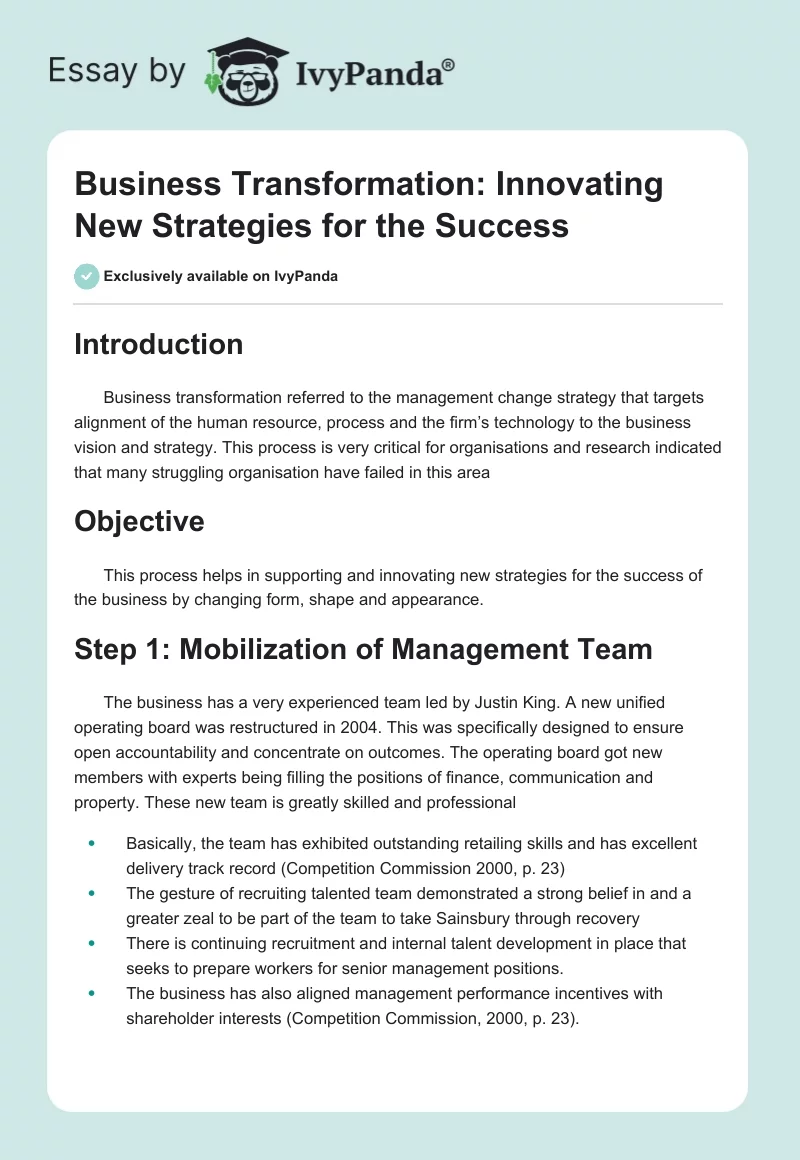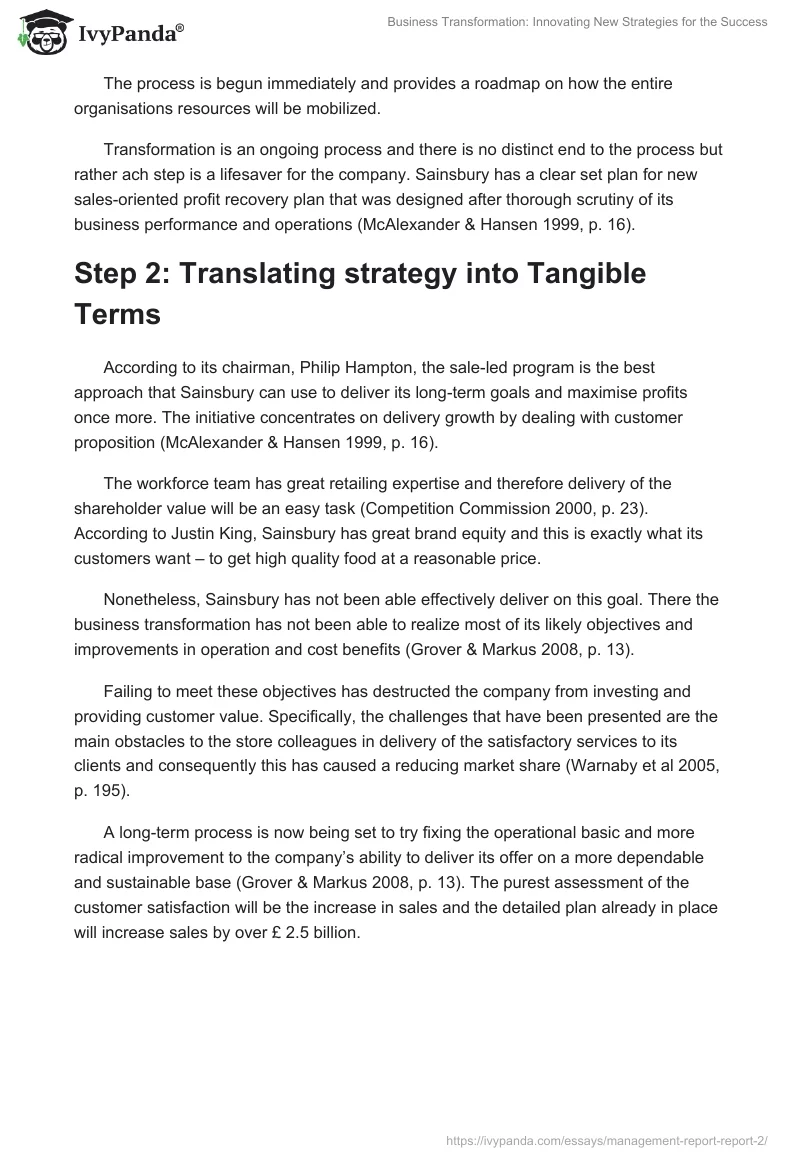Introduction
Business transformation referred to the management change strategy that targets alignment of the human resource, process and the firm’s technology to the business vision and strategy. This process is very critical for organisations and research indicated that many struggling organisation have failed in this area
Objective
This process helps in supporting and innovating new strategies for the success of the business by changing form, shape and appearance.
Step 1: Mobilization of Management Team
The business has a very experienced team led by Justin King. A new unified operating board was restructured in 2004. This was specifically designed to ensure open accountability and concentrate on outcomes. The operating board got new members with experts being filling the positions of finance, communication and property. These new team is greatly skilled and professional
- Basically, the team has exhibited outstanding retailing skills and has excellent delivery track record (Competition Commission 2000, p. 23)
- The gesture of recruiting talented team demonstrated a strong belief in and a greater zeal to be part of the team to take Sainsbury through recovery
- There is continuing recruitment and internal talent development in place that seeks to prepare workers for senior management positions.
- The business has also aligned management performance incentives with shareholder interests (Competition Commission, 2000, p. 23).
The process is begun immediately and provides a roadmap on how the entire organisations resources will be mobilized.
Transformation is an ongoing process and there is no distinct end to the process but rather ach step is a lifesaver for the company. Sainsbury has a clear set plan for new sales-oriented profit recovery plan that was designed after thorough scrutiny of its business performance and operations (McAlexander & Hansen 1999, p. 16).
Step 2: Translating strategy into Tangible Terms
According to its chairman, Philip Hampton, the sale-led program is the best approach that Sainsbury can use to deliver its long-term goals and maximise profits once more. The initiative concentrates on delivery growth by dealing with customer proposition (McAlexander & Hansen 1999, p. 16).
The workforce team has great retailing expertise and therefore delivery of the shareholder value will be an easy task (Competition Commission 2000, p. 23). According to Justin King, Sainsbury has great brand equity and this is exactly what its customers want – to get high quality food at a reasonable price.
Nonetheless, Sainsbury has not been able effectively deliver on this goal. There the business transformation has not been able to realize most of its likely objectives and improvements in operation and cost benefits (Grover & Markus 2008, p. 13).
Failing to meet these objectives has destructed the company from investing and providing customer value. Specifically, the challenges that have been presented are the main obstacles to the store colleagues in delivery of the satisfactory services to its clients and consequently this has caused a reducing market share (Warnaby et al 2005, p. 195).
A long-term process is now being set to try fixing the operational basic and more radical improvement to the company’s ability to deliver its offer on a more dependable and sustainable base (Grover & Markus 2008, p. 13). The purest assessment of the customer satisfaction will be the increase in sales and the detailed plan already in place will increase sales by over £ 2.5 billion.
Step 3: Aligning Business and Support
Profit Recovery Process
The plans that are outlined in the Sainsbury’s business transformation program are designed to drive profits recovery by regenerating sales growth and also by changing the cost structure of the business (McAlexander & Hansen 1999, p. 16). This would make sure that the operations directed towards sales growth are achieved. The major drivers for the recovery of sales include the following;
- Investing in the consumer offer particularly quality, price and service.
- Managing a tight cash flow (Barnes 2002, p. 83)
- Maintaining operating cost efficiencies of over £400 million
- Maintaining a Strong property asset support (Barnes 2002, p. 84)
Customer Offer
Sainsbury will reignite its complex operating model that focused on what made customers different rather than what unites them. This is the major complexity of the model and has been a major obstacle in delivery of customer service. With its national presence, Sainsbury will go back to its major strengths and focus on diet, nutrition and health requirements (Warnaby et al 2005, p. 195).
Additional, the company will make more investment into customer offer to improve the product quality. Sainsbury will also refocus on its traditional offer of fresh and labelled products to reconstruct its repute of innovativeness and quality goods at a reasonable price (Grover & Markus 2008, p. 13). In particular, bands like Taste the different have been successful.
The business plans to maintain competitive prices on its brand and backed by strong and efficient promotional program for its product ranges (Grover & Markus 2008, p. 34). There is also the Sainsbury home offer in place though slightly expensive.
Step 4: Striving to Perfect
Simplified Store Format
There have been little focus on the customer offer but this is soon to change because of the new strategy of reducing complexity of store layout. The store formats are being simplified into just stores of convenience and supermarkets (Warnaby et al 2005, p. 196). The stores now focus on customer service and the central and Savacenters stores are now being transformed into supermarket.
The IT Systems
The Information Systems faced a great challenge and for quite some time failed to deliver. However, there has been a positive response in the online services and it’s anticipated that the business productivity will increase because of the online services (Kerzner 2009, p. 67). The transformation process is seeking to simplify and enhance efficiency of the stores in service delivery.
Major initiatives here include slowing of the future rollout and upgrading but rather concentrated on the driving benefits from the current systems in place (Palmer & Hartley 2006, P. 73). Priority is now being placed on forecast and scheduling processes.
The contract with Accenture will be re-negotiated to include the management more fully so that they can select and implement systems and Information technology solution (Grover & Markus 2008, p. 13). The company is therefore restructuring its in-house potential.
Broad organisational Structure
Introduction
Organisation structure entails the manner in which a business organisation is organized in terms of categorization and delegation of task in order to achieve inst specified goals. It also determines the way decisions will be made and executed all the business levels.
Objective
The organisation structure offers a framework of management and accountability. Creation of specific job categories increases efficiency of the organisation. This indicates chain of command and distribution of authority.
J Sainsbury Plc employees a decentralized organisation from the board to the production employees; this has given the company a group or divisional model as far as structure is concerned.
While the major concentration would appear to be at the chairman’s desk, the changes of in the organisation structure since 2004 were described as convenience division and were designed to increase efficiency and not to distract other businesses like Jackson and T&G from their basic supermarket layouts (Heinelt & Smith 2003, p. 121). The management changes were very crucial for restoring the fortunes of Sainsbury.
Appointment of Justin King to the position of chief executive was to ensure that he had more control over the daily operations of the firm. He is a well experience person for the position having worked for major food companies in the UK before joining Sainsbury. He had previously worked at Spencer and Marks as a director of food and he was the managing director of Hypermarket when he was in ASDA.
Board of Directors
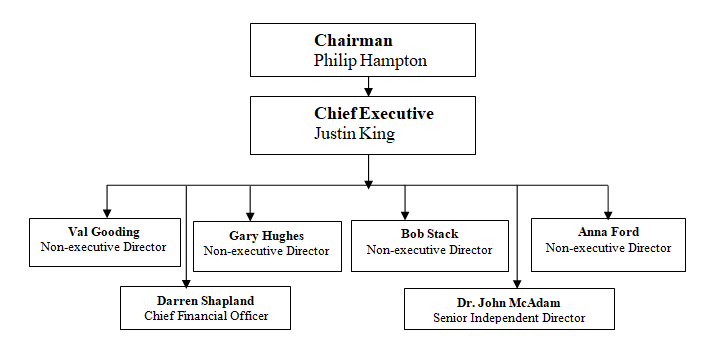
This decentralised system has several merits and demerits. Basically the structure is very efficient when the unit managers and the workers have specialised skill concerning that particular unit. The unit managers can be given the authority to train the best performing employees so that they are prepared for the future management position in the spirit of upholding transformational leadership (Palmer & Hartley 2006, P. 73).
This is one way of empowering employees even at the lowest level and it goes a long way in building their motivation and satisfaction at work when they are involved in decision making.
Management Structure
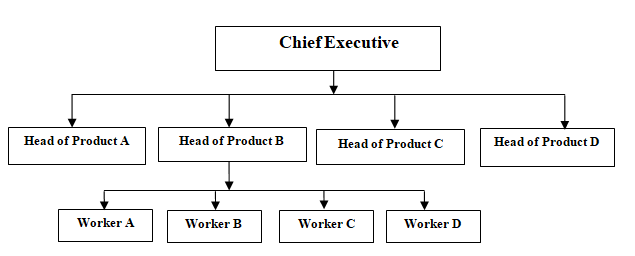
In decentralised system, the company is able to make use of the division of about to its advantage by sharing din decision-making. Employees are empowers and their performance improves as a result because they will be able to work on their weaknesses without requiring the long approval process of centralised system.
The managers of company are able to use their first hand knowledge and experience to enhance performance and initiate better changes (Palmer & Hartley 2006, P. 76). Individuals in the organisation feel trusted and they hence share accurate information based on accurate thought.
The senior managers are allowed more time to focus on the more pertinent decision since other simple tasks can be attended to by the workers (Barnes 2002, p. 83). This will allow them to make more effective decision than a single senior would have done.
Workers are more familiar and have greater understanding on their workplace hence they can respond faster to the challenges and changes before the manager do. This also makes them to easily accept responsibility (Pearce & Robinson 2008, p. 121).
The disadvantages of the decentralized system is that there are subunit managers who could develop some fear or myopic perception of that subunit of the organization and ignoring wider consequence and impact of the organization activities (Heinelt & Smith 2003, p. 121).
Decentralization of the organization can result in duplicate results of several administrative functions and services at a unit level which would have rather been conducted in a more efficient manner in a centralized (Pearce & Robinson 2008, p. 121).
Decentralized organizations do not have concentrated authority and cannot act so authoritatively (McGee et al 2005, p. 106). Decision making are made at a lower level of organizations hierarchy. Franchise food chains are normally responsible for their own performance and operations. The idea of placing decision making to a larger group is perceived as taking the responsibility of running the organization to the ground floor (Blythman 2004, p. 58).
Marketing
Introduction
Marketing one of the key business operations is very vital for survival and growth of a business because of its contribution. All other process like distribution and production all rely on marketing. Marketing entails sales, PR, advertising and promotion.
Objective
The goal of marketing is to create the awareness of services and products. This awareness is what causes the purchase process hence leading to sales.
Business Environment
Analysis of the business environment is very important before coming up with a marketing strategy. The marketing style adopted by Sainsbury groceries and supermarkets.
The most important players to consider when designing a marketing scheme are the clients and the competitors (Smith 2007, p. 56). This will allow buyer behaviour can be manipulated to benefit the business by purchasing more while keeping a competitive advantage over competitors.
Basically the current business environment shows that the number of buyers is reducing as the credit crisis has led to loss of jobs and the consequence of this is reduced purchases as many people cut down of some of their expenditure (McGee et al 2005, p. 106). The current estimated consumer cut down is about 57%.
Marketing Strategy
Sainsbury Groceries and supermarkets are struggling very had to stay at the top of the business and also venturing into other countries (Doyle 2002, p. 134). The risk of recession presents an opportunity for innovation and the supermarkets have advertised their land requirements in the media and have predicted an enormous increase.
Changing the supermarket designs is very critical for marketing (Pearce & Robinson 2008, p. 126). Marketing managers have a duty to design a marketing mix that is unique to the business and one that will build customer loyalty. Sainsbury product portfolio range from alcohol brands, bakery, cereals, desserts, sweets, fruits and vegetables, pasta and dried foods, pets and health and beauty products.
The foods are displayed in fridges and this offers wide-ranging fresh products to customers. The aisles should be designed in attractive manner in that the discount tags are colourfully displayed. To add to the diverse the product portfolio, the supermarkets should provide seasonal delicacies like barbecues.
Managing prices will also be a crucial task for marketing manager and they will be required to adopt a reasonable price for the products especially in these hard economic times (McGee et al 2005, p. 107).
The Sainsbury groceries should adopt price cuts and give offers in order to keep up with the competition from each other players in the market like Tesco, Aldi, Lidl and Netto which are highly competitive. The current statistics reveals that the value line of Tesco products is lower making these goods cheaper than those offered by Sainsbury.
Sainsbury marketing managers need to maintain good working relationship with financial institutions like banks because they are very critical players to the business especially when they need to keep up the expansion that has been recorded over the past years or improve on it (Doyle 2002, p. 134).
Competitive Advantage
Different groceries and supermarket have different competitive advantages Sainsbury is a widely known to be a low cost operator. This firm offers food products to clients at relatively low price and be able to make profits based on the financial operation structure.
This has actually been referred to as its major competitive advantage. Such level of operation resulted in the benefits of economies of scale enabling the firm to provide low priced goods (Kerzner 2009, p. 69). This differentiates it from the rest of supermarkets making it a unique strategy.
This has placed the firm at an advantaged position in terms of competitiveness. The main aspect of this strategy is the way it has utilized the lifestyle format for supplying goods. The company also concentrates on differentiating itself by ensuring that it’s the first one to be dealing in superior quality perishables like seafood, bakery, deli, meat and flowers.
Some groceries usually operate without clear strategy but still the manage to have a competitive advantage because of varied marketing strategies (Brassington & Pettitt 2006, p. 145). They brag of achieving their competitive advantage (and economies of scale) by applying a combination of strategies particularly being both a wholesaler and a retailer.
The PESTE Analysis
Introduction
In any business it’s very imperative that macro-environments are analysed. This helps a business to identify the changes that are ongoing in the society and have a plan on how to deal with them.
Objective
This process assists in identification of the factors that can affect important business variables. There is a checklist (PESTE) which has been developed for this purpose. This is a strategic tool that helps to understand the position of the business, market growth/decline and the direction operations are talking.
PESTE
For the J Sainsbury plc PESTE C analysis, it’s very critical that recommendations should be drawn based on the conclusion drawn from the evaluation of the environmental factors that influence business operation.
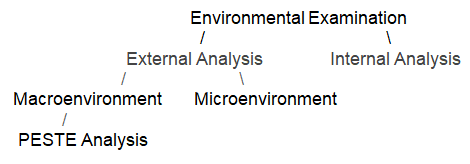
The Political Environment
The current market calls for expansion superior quality products due to globalization so as to secure a bigger market share. Venturing in to other countries would require that Sainsbury comply with the regulations in those countries (Hughes & Merton 1996, p. 3).
Sainsbury is likely to fight against unknown external forces to acquire the best quality of raw materials that are profitable from sources throughout the world. An alternative would be to join other business ventures so as to explore the foreign market through amalgamations though currently it has no such intentions.
Other top retailers are conducting a research on the pricing of retailer products in the U.K with an intention of price fixing strategy. This would definitely have a negative outcome on the operations of Sainsbury as it’s the most suspected for this strategy (Hughes & Merton 1996, p. 3).
The company reputation may get tarnished as a result of these crises. The U.K government is working on a plan to reduce the corporation tax by 2%, this will have positive impact as large company’s like J Sainsbury will save a great deal of money.
The Economic Environment
The rising global economic crisis that has led to fall in the U.S share prices is an issue of major concern. The U.S being the backbone of the world economy could bring problems to Britain as the two nations always work together to keep up business opportunities. There are liquidity problems that need to be addressed by the government by changing the economic policies (Jackson 2000, p. 2).
The world food crisis is set to see food prices go higher and higher and as a consequence of higher purchasing costs by the J Sainsbury plc, the effects are most likely to be past to the customers in terms of increased prices of food products in the Sainsbury supermarkets (Hughes & Merton 1996, p. 3).
The world is also experiencing problems in the fuel market as the prices have kept on rising over the past few years, the continuation of such trend in the fuel prices will therefore lead to expensive chain of supply and consequently transferring these costs to the consumers (Jackson 2000, p. 2). The world is experiencing credit crunch in the management of financial sector.
In Britain, the credit crunch is likely to have a double impact (Hughes & Merton 1996, p. 4). The company’s financial services will be the hard hit. There will be reduced customers’ purchasing power due to the credit crunch is likely to regulate buying with clients opting for the most essential products and services.
Since Sainsbury provides these services and products (food), it’s likely to retain market share and a greater profit margin. The Sainsbury bank on the other hand will be affected greatly and may lose ability to lend money since it has not yet established a good reputation in the financial provision industry (Hughes & Merton 1996, p. 4).
In the current world of liberalization, there are many business ventures coming up in the retail sector resulting in increased competition and this tends to bring down prices of products as many businesses are giving incentives to customers.
The Socio-Cultural Environment
The increased knowledge and education in the general population has dynamically changed people’s lifestyles and more so their eating habits. Emphases have shifted towards healthy eating habits and this has encouraged eating fresh and simply prepared food (Leigh & Waddock 2006, p. 410).
This presents a wonderful chance for Sainsbury to introduce new recipes that encourage healthy and modest eating habits (McAlexander & Hansen 1999, p. 21).
The U.K government on the other hand is advocating for healthy eating basically because of the rising numbers of patients suffering from obesity in the country (Leigh & Waddock 2006, p. 410). With the trend set to last, Sainsbury could benefit a lot from this encouragement by the government and stock up healthy food stuffs and join the campaign for healthy eating and promote their products (Hughes & Merton 1996, p. 4).
The Technological Environment
Technology has played a crucial role in most business organization as it has made easy the marketing process and is encouraging innovation and development of quality products and services. The internet has attracted online shopping and it’s estimated that the U.K alone accounts for more than a third of the revenue collected.
The Sainsbury plc can use the internet to its advantage by leveraging its services so as to beat some of its competitors like Tesco who also uses online delivery system. The online services failed to pick up well when they were first introduced by right now the services are picking up very fast and the online clients are increasing steadily (Jackson 2000, p. 3).
Customers usually suffer the long queues at the checkout points in Sainsbury supermarket and adoption of automatic or self check out machines would greatly solve the congestion problem just like in Tesco and ASDA companies. The self check out machines can be used to operate at night hence allowing a 24/7 service at Sainsbury therefore increasing sales.
Sainsbury is set to implement IT in most of its operations including human resource management, marketing, and other business operations to reduce paperwork and problem of documentation. This will make the work very easy for the management and operation will be smooth and efficient (Dixon 2005, p. 175).
The Ecological Factors
The green house effect of the gases that are released in to the environment has been an issue of concern and currently it’s not just a backburner matter any longer (Dixon 2005, p. 172), most business ventures like Sainsbury and all other organisations are required to show that they are cutting down on the greenhouse fumes they release or they should devote their corporate function to projects like green technology of using bio-fuel.
Dumping and environment pollution is a critical factor and the business is required to have a better waste management strategy. The environmental matter is very tricky and Sainsbury might have to struggle very hard in balancing their general opinion on environment conservation without losing clients as a result of price increase (Dixon 2005, p. 172).
This is because as much as environmental conservation has to be taken seriously, there are some consumers who are price conscious and would tend not to buy when prices go up in the name of environmental conservation. Sainsbury is required to manage its landfill appropriately not to cause environmental pollution.
System Theory
Introduction
The need to understand management techniques has brought about increased concerns of management styles. This led to the devilment of modern management theories which include the classical theories of management.
Previous management theories contradicted and were incoherent leading to new theories that integrated and synthesized various schools into one logical and solid theory. System theory blends several theories grouping the business operations into process.
Objective
System theory offers managers with an instrument to analyse organisational dynamics without restriction of the analysis to a specific way of managing the organisation.
The Theory
The social system school’s point of view is that the organisation is system that is made up of entities that interact and are interdependent. As a system therefore, the organisation is made up of several subsystems and everyone of these subsystems are in their own right a system made up of more subsystems which are interdependent as well and that they are also interacting (Sridhar 2010, p. 12).
These different subsystems of the organisation are connected to one another via networks of communication, management, responsibilities, goals, decisions, authority and other relationships (Sridhar 2010, p. 12). The social system therefore pushes workers to establish networks at work or social groups so as to be able to take part on managerial roles and allow democratic behaviour of the organisation.
The major drawback of classical theory of management is that it puts more emphasis on a single aspect of an organisation at the expense of other. Systems theory put emphasis on the integration of people, structure, efficiency and duty. This is a more holistic approach that can help in solving management problems as it gives a look at the organisation as a whole (Sridhar 2010, p. 12)
An organisation is hence just like a body of a man and the use of the term ‘interdependent’ is very essential and it means that managers should not seek for single cause of a problem in the organisation as a system cannot be closed or open, it neither because even an open system will still relate and intermingle with the surroundings (Sridhar 2010, p. 12).
For Sainsbury, this concept is of special role because the management of the organisation is decentralised and therefore it allows more brainstorming and therefore deduction of several causes of a problem and consequently an array of possible solutions (Sridhar 2010, p. 12). This allows a holistic approach of problem resolution.
Traditional theorists assumed that organisation were closed systems but modern studies tend to depict organisations as open systems with constant interaction between the organisation and the environment. This means that an organization has to constantly interact with external environment which include forces like consumers, suppliers, government agencies and competitors.
These external forces have a great impact on the organisation and as revealed issues like economic crises change the building behaviour of customers hence reducing sales (Sridhar 2010, p. 12). Government policies can affect marking and promotional activities as well. This is why Sainsbury promotes healthy eating and was adversely affected by the economic crunch of 2008.
The interdependence issues are of great important because a change in one aspect causes a change in the other (Sridhar 2010, p. 13). And this complicates the roles of the managers. Management are requires to function like boundary connection between subsystems of the organisation.
Open system have very permeable boundaries, that are also flexible and changeable based on the type of activities that are going on (Jeston 2009, p. 92). A decentralised system allows the type of relationships and that is why Sainsbury departments or stores can interact at that level without involvement of official communication protocol via the management hierarchy (Sridhar 2010, p. 13).
The flow of information in systems and the resources are transformed into the output of products, satisfaction and service. This provides synergy, a concept where the outcome of the whole organisation is more than the combined outcome of the department or subunits singly.
This mean the interrelated parts are more product when working in combination that individually (Sridhar 2010, p. 13). System theory allows adaptation to the changing environments and the management exercises the controls over the performance and operations via information feedback. Information in this case flows to the correct people as feedback to enable this role.
Conclusion
This management report offers analyses of external and international environments and it’s a very strategic tool for Sainsbury to understand its bigger picture of their environment of operation. This will allow the business to capitalise on the opportunities and mitigate threats that the business may face.
If strategic planning is done correctly it will be a concrete plan for the growth of the firm and survival in the 21st century economy. This report offer a longer horizon of time and its able to elucidate strategic opportunities of the organisation and impending threats hence allowing the business to strategically use the information of business today to design survival plan for the future.
Reference List
Barnes, S., 2002, Knowledge Management Systems: Theory and Practice. London: Thomson Learning.
Blythman, J., 2004, Shopped, the Shocking Power of British Supermarkets. London: Fourth Estate.
Brassington, F., & Pettitt, R., 2006, Principles of Marketing. 4th Ed., Harlow: Prentice Hall.
Competition Commission. 2000. Supermarkets – A Report on the Supply of Groceries from Multiple Stores in the United Kingdom. London: The Stationery Office.
Dixon, T. J., 2005. The Role of Retailing in Urban Regeneration. Local Economy, Vol. 20, No. 2, pp. 168 – 182.
Doyle, P., 2002. Marketing Management and Strategy. 3rd Edition. Essex: Pearson Education.
Grover, V., & Markus, L., 2008, Business Process Transformation. New York: MS Sharpe.
Grover, V., & Markus, M. L., 2008, Business Process Transformation: Advances in Management Information, Systems Series. Armonk, NY: M.E. Sharpe.
Heinelt, H., & Smith, R., 2003, Sustainability, Innovation and Participatory Governance. Aldershot: Ashgate.
Hughes, D., & Merton, I., 1996, Partnership in Produce: The J Sainsbury Approach to Managing the Fresh Produce Supply Chain. Supply Chain Management: An International Journal, Vol. 1 Issue 2, pp. 4 – 6.
Jackson, M.C., 2000, Systems Approaches to Management. London: Springer.
Jeston, J.C., 2009, Beyond Business Process Improvement, on to Business Transformation: A Manager’s Guide. Tampa: Meghan-Kiffer Press.
Kerzner, H., 2009, Project Management: A Systems Approach to Planning, Scheduling, and Controlling. Hoboken, NJ: John Wiley and Sons.
Leigh, J., & Waddock, S., 2006, the Emergence of Total Responsibility Management Systems: J. Sainsbury’s (Plc) Voluntary Responsibility Management Systems for Global Food Retail Supply Chains. Business and Society Review, Vol. 111, pp. 409–426.
McAlexander, J. A., & Hansen, E., 1999, J Sainsbury Plc and the Home Depot: Retailers’ Impact on Sustainability. Washington, D. C.: Island Press.
McGee, J., Thomas, H., & Wilson, D., 2005, Strategy: Analysis and Practice. Maidenhead: McGraw-Hill.
Palmer, A., & Hartley, B., 2006, the Business Environment. 5th Ed. Maidenhead: McGraw-Hill.
Pearce, J., & Robinson, R., 2008, Formulation, Implementation and Control of Competitive Strategy. 11th Ed. Maidenhead: McGraw-Hill.
Smith, M., 2007, Fundamentals of Management. Maidenhead: McGraw-Hill.
Sridhar, M.S., 2010. Schools of Management Thought, Managerial Quality and Leadership Styles. Web. Web.
Warnaby, G., Bennison, D., & Davies, B. J., 2005. Retailing and the Marketing of Urban Places: A UK Perspective. International Review of Retail, Distribution and Consumer Research, Vol. 15, No. 2, pp. 191-215.

